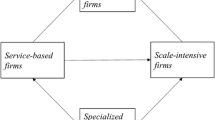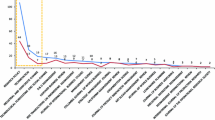Abstract
Based on co-citation cluster analysis, we propose a knowledge-transfer analysis model for any technology field. In this model, patent data with backward citations to non-patent literature and forward citations by later patents would be analyzed. Co-citation clustering of the cited articles defines scientific knowledge sources, while that of the patents themselves defines technology fronts. According to the citation between the article and patent clusters, the landscape of knowledge-transfer including route and strength between scientific knowledge sources and technology fronts can be mapped out. The model has been applied to the field of transgenic rice. As a result of the analysis, ten scientific knowledge sources and eight technology fronts have emerged, and reasonable links between them have been established, which clearly show how knowledge has been transferred in this field.



Similar content being viewed by others

References
Chen, C. M., & Hicks, D. (2004). Tracing knowledge diffusion. Scientometrics, 59(2), 199–211.
Han, Y. (2004). Knowledge-transfer and its analysis methods: From basic research to technology. Doctoral Dissertation of Tianjin University, China.
Hu, C. P., Hu, J. M., Gao, Y., & Zhang, Y.-K. (2011). A journal co-citation analysis of library and information science in China. Scientometrics, 86(3), 657–670.
Lai, K. K., & Wu, S. J. (2005). Using the patent co-citation approach to establish a new patent classification system. Information Processing and Management, 41(2), 313–330.
Meyer, M. (2000). Does science push technology? Patents citing scientific literature. Research Policy, 29, 409–434.
Mogee, M. E. (1991). Patent co-citation analysis of Eli Lilly & Co. patents. Expert Opinion on Therapeutic Patents, 9(3), 291–305.
Mogee, M. E., & Kolar, R. G. (1998). Patent citation analysis of Allergan pharmaceutical patents. Expert Opinion on Therapeutic Patents, 8(10), 1323–1346.
Narin, F., & Noma, D. (1985). Is technology becoming science? Scientometrics, 7(3–6), 369–381.
Neil, R., Quinn, J. R., & Breuer, Melvin A. (1979). A forced directed component placement procedure for printed circuit boards. IEEE Transactions on Circuits and Systems, 26(6), 377–388.
Pang, J. (2011). Research on measuring S&T fronts based on theoretic framework of knowledge flow—a case study on solar cell. Doctoral Dissertation of Dalian University of Technology, Dalian.
Schiebel, E. (2012). Visualization of research fronts and knowledge bases by three-dimensional areal densities of bibliographically coupled publications and co-citations. Scientometrics, 91, 557–566.
Small, H. (1973). Co-citation in scientific literature: A new measure of relationship between two papers. Journal of the American Society for Information Science, 24(4), 265–269.
Small, H., & Sweeney, E. (1985). Clustering the science citation index using co-citations.I. A comparison of methods. Scientometrics, 7(3–6), 391–409.
Small, H., Sweeney, E., & Greenlee, E. (1985). Clustering the science citation index using co-citations.II. Mapping science. Scientometrics, 8(5–6), 321–340.
OECD (2011). The section of “Connecting to Knowledge”. OECD Science, Technology and Industry Scoreboard 2011. OECD Publishing.
Toriyama, K., & Arimoto, Y., et al. (1988). Transgenic rice plants after direct gene transfer intoprotoplasts. Bio/Technology, 6, 1072–1074.
Wang, X. W., Zhang, X., & Xu, S. M. (2011). Patent co-citation networks of Fortune 500 companies. Scientometrics, 88, 761–770.
Website of JST: http://foresight.jst.go.jp/en/jst_indicators/tech_linkage/. Accessed 27 March 2013.
Zhang, W., & Wu, R. (1988). Effieient regeneration of transgenic plant from rice protoplasts and correctly regulated expression of the foreign gene in the plant. Theoretical and Applied Genetics, 76(6), 835–840.
Zhao, D. Z., & Strotmann, A. (2011). Intellectual structure of stem cell research: A comprehensive author co-citation analysis of a highly collaborative and multidisciplinary field. Scientometrics, 87, 115–131.
Acknowledgments
The research was supported by Youth Talent Frontier Project of Knowledge Innovation Project of National Science Library of Chinese Academy of Sciences (Grant No. Q110031). The authors would thank Dr. B. Zhang for helpful identification and discussion on the details of article and patent clusters, and Dr. T. Han for helpful discussion on the analysis model.
Author information
Authors and Affiliations
Corresponding author
Rights and permissions
About this article
Cite this article
Wang, X., Zhao, Y., Liu, R. et al. Knowledge-transfer analysis based on co-citation clustering. Scientometrics 97, 859–869 (2013). https://doi.org/10.1007/s11192-013-1077-6
Received:
Published:
Issue Date:
DOI: https://doi.org/10.1007/s11192-013-1077-6



